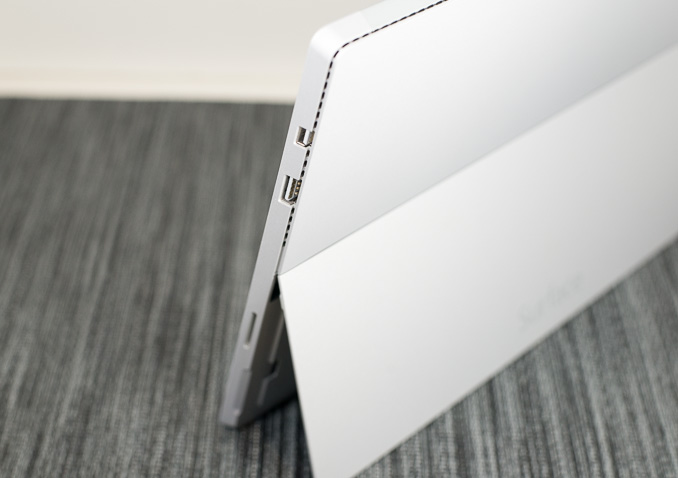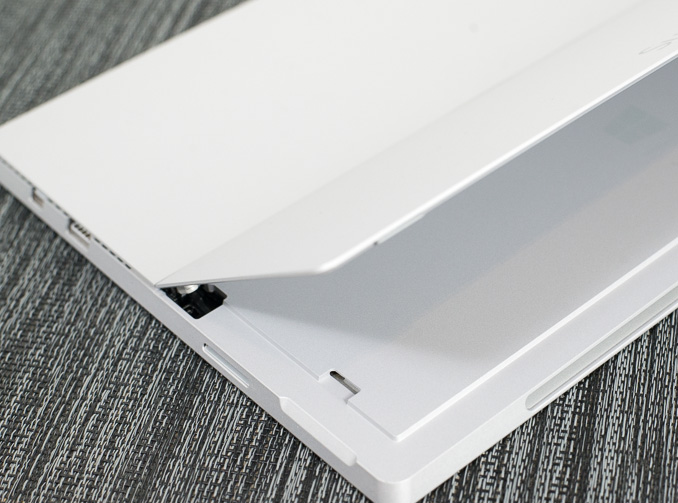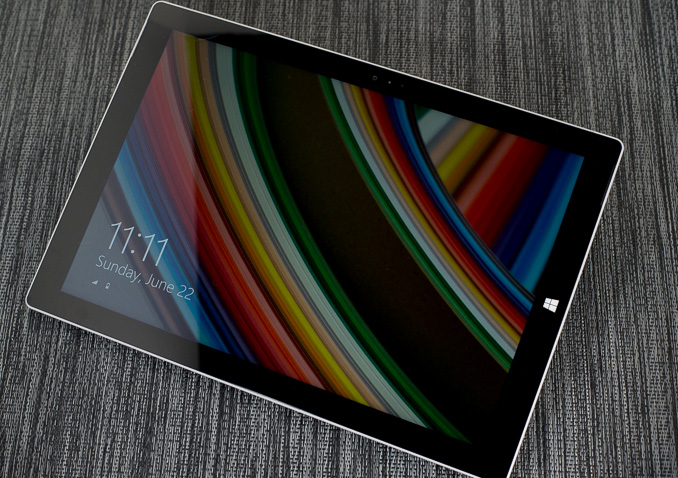Microsoft Surface Pro 3 Review
by Anand Lal Shimpi on June 23, 2014 3:55 AM ESTFinal Words
When I reviewed the first Surface Pro I was intrigued by the idea, but felt it needed a few more iterations to get to the right point. In less than two years what we have in front of us looks very different than Microsoft's original vision for the platform. Display size, aspect ratio and even the mechanics of the whole thing are all quite different. The changes are for the better as Surface Pro 3 is a much better laptop and a much better tablet than any of its predecessors. The device no longer feels cramped and tiring to use as a laptop. The new Surface Pro no longer feels heavy to use as a tablet either. It's truly an improvement on both vectors.
Microsoft might be overselling the design to say that it truly is the only device you need. Like most compromises, Surface Pro 3 isn't the world's best laptop nor is it the world's best tablet. It serves a user who wants a little of column A and a little of column B.
The device's "lapability" is tremendously better than any of its predecessors. While I wrote all of the previous Surface reviews on the very Surface devices I was reviewing, this is by far the most comfortable one to use as a laptop. It's still not perfect, and you still need a fairly long lap to make it work, but the design is finally really usable as a laptop.
As a tablet the thinner and lighter chassis is much appreciated. The new kickstand remains one of the best parts of the design, enabling a flexibility unmatched by any other tablet. Tent mode in particular is awesome for tablet usage models.
Surprisingly enough the move away from Wacom to an active NTrig pen model comes with very few issues. The device could use some tuning of its pen pressure curves. Applying max pressure on the screen now distorts the LCD, something I'm never comfortable doing. But overall the new pen gives up very little and even improves performance and functionality.
The new Type Cover is awesome. The keyboard is probably as good as it's going to get, and the new trackpad is finally usable. The latter isn't perfect but it's so much better than anything that's come before it.
The device also launches with a far more polished version of Windows. With its latest updates, Windows 8.1 is a far cry from where it first started. I still think there's lots of room for improvement, but it's clear that Microsoft is marching towards a more cohesive vision of modern and desktop Windows UIs.
The downsides for Surface Pro 3 are obvious. Windows 8.1 remains a better desktop/notebook OS than a tablet OS. Yet in a device like Surface Pro 3 where you're forced to rely on touch more thanks to a cramped trackpad, I'm often in a situation where I'm interacting with the Windows desktop using the touchscreen - a situation that rarely ends well. As Microsoft improves the behavior of its modern UI apps, I would love to see a rethinking of what touch looks like on the desktop. If Surface Pro 3 exists to blur the lines between laptop and tablet, Windows 9 needs to do a better job of the same. The desktop needs to react better to touch and the modern apps need to feel even more integrated into the desktop.
On the hardware side, the device is a compromise. You have to be willing to give up some "lapability" in order to get a unified laptop/tablet device. Whether what you get as a tablet is worth the tradeoff is going to be up to how good of a tablet OS Windows 8.1 is for you. Personally I find that Android and iOS deliver better tablet experiences particularly when it comes to 3rd party applications. If everything you need on the tablet front is available in the Windows Store however then the point is moot.
Those users upgrading from Surface Pro 2 may notice a regression in performance, particularly when it comes to running prolonged CPU/GPU intensive workloads. In games, the difference can be noticeable. The simple fact is that in becoming a thinner device, Surface Pro 3 inherited more thermal constraints than its predecessors. While performance regressions aren't ideal, in this case I can appreciate what Microsoft has done. From the very beginning I wanted a lower TDP part in a thinner chassis. Had Microsoft done that from the start we wouldn't have seen any performance regression but rather a steady increase over time. From my perspective, Surface Pro 3 is simply arriving at the right balance of thermals and performance - the previous designs aimed too high on the performance curve and required an unreasonably large chassis as a result.
The remaining nitpicks are the same as last time: Microsoft needs to embrace Thunderbolt, and a Type Cover should come with the device. The display's color accuracy is good but grayscale performance needs some work.
Surface Pro 3 is easily the best design Microsoft has put forward. If you were intrigued by the previous designs, this is the first one that should really tempt you over. I was a fan of the original Surface Pro, and with Surface Pro 3 I think Microsoft has taken the hardware much closer to perfection. At this point the design needs more help on the software side than hardware, which is saying a lot for the Surface Pro hardware team. Personally I'd still rather carry a good notebook and a lightweight tablet, but if you are looking for a single device this is literally the only thing on the market that's worth considering. I don't know how big the professional productivity tablet market is, but it's a space that Microsoft seems to have almost exclusive reign over with its Surface line. With its latest iteration, Microsoft is serving that market better than ever.













274 Comments
View All Comments
mkozakewich - Monday, June 30, 2014 - link
Not as much to do with cost. They were trying for thinness. I doubt they'll thin it more next time, because its current size is actually very nice. They don't need to reach iPad levels, they just needed to get to an acceptable tablet size.For an "ideal tablet PC", you'd probably be doing a lot less, and not spending all your time rendering at 99% CPU usage. I'd set the power configuration to use as little power as possible, and that would probably give good thermal performance. For instance, I'm running my Surface Pro (original) at full brightness and also charging it, but the fan hasn't come on because I'm in power-saving mode.
nos024 - Monday, June 23, 2014 - link
I don't mind not having an SD card slot as long as it has USB ports for a Windows based system. There's tons of USB flash drives that are dirt cheap as well as USB adapters for SD cards. I do mind if my phone or tablet (android-based) device doesn't have it.Also, I'd like to have a replaceable battery or so-called "end-user" replaceable battery. If the battery malfunctions, the system is basically toasted. I hate to have a battery to likes to overheat and not charge up properly just right outside the warranty period - like my tablet.
ymcpa - Monday, June 23, 2014 - link
This has both a microsd and a USB port. You just won't get a user replaceable battery in premium products. the products that have one use a flimsy plastic cover. All devices that are thin and light weight and use premium materials also can't be opened easily. Although, the surface is near impossible to open. The ipad can be opened with some skill.mkozakewich - Monday, June 30, 2014 - link
This isn't a budget laptop/tablet, and it uses a premium battery. It should last a few years before you notice any wear, if you treat it right. They do have a battery-replacement program, too.savaytse66 - Monday, June 23, 2014 - link
I'm pretty sure this does have a MicroSD slot that supports up to 128GB...mkozakewich - Monday, June 30, 2014 - link
If it's SDXC, it should support up to 2 TB.cparker09 - Monday, June 23, 2014 - link
The $200 price increase from 64 to 128 GB SSD is also accompanied by a move from i3 to i5. Seems like a decent price step up, considering they also need to differentiate units.Tigran - Monday, June 23, 2014 - link
***In prolonged workloads you'll see a bit of a gap, and even a slight regression vs. Surface Pro 2 due to the thermal design targets for the new chassis***Isn't it due to higher screen resolution (1,440 x 2,160 vs 1,080 x 1,920)? I wonder how two identical GPUs (HD 4400) performed nearly equally while Pro 3 screen resolution is x1.5 higher than Pro 2.
randomhkkid - Monday, June 23, 2014 - link
The resolutions are both set to 1080p.Tigran - Monday, June 23, 2014 - link
Thanks.